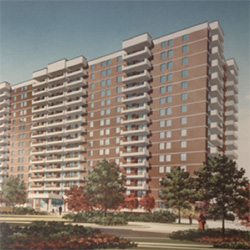There are some steps that can be taken to reduce second-hand smoke in multi-unit housing. These could include:
Talking to neighbours / building tenants
- Talk to tenants who smoke. They might not realize that the smoke is a problem for others. Try to focus on solutions such as asking them to smoke outside or to close doors or windows.
- Talk to other tenants in the building. They might have the same problem and a solution can be found together
- Think about a survey to find out what people in the building think. Most renters in Ontario would prefer a smoke-free building
Sealing units to reduce second-hand smoke transfer
- Use caulk or spray-in foam around plumbing, electrical outlets, phone jacks, fixtures, cracks and gaps
- Close windows and doors
- Weather-strip windows and install door sweeps
- Cover or block heating/cooling grilles
- Fill or patch cracks in walls and ceilings
- Insulate air spaces around plumbing pipes
Investigating the ventilation
According to the Canada Mortgage and Housing Corporation, most apartments built after the mid-1960s have corridor ventilation systems. These systems are designed to deliver outside air into corridors to maintain positive pressure. Air is continuously pushed under doors, thereby preventing odours from escaping individual units and leaking into the corridors and neighbouring apartments. Older buildings rely on air coming in through cracks and gaps for ventilation. In addition, many apartments have exhaust systems to ventilate the bathrooms and kitchens, with fans either right in individual units or located centrally elsewhere in the building.
- If smoke is entering units under the front door from other units, the ventilation system should be checked to make sure that it is working properly. Sometimes the systems operate on a timer and the schedule may need to be adjusted.
- If smoke is coming into units from a bathroom or kitchen fan, try the tissue test. Turn on the kitchen or bathroom fan and hold a tissue to the grille. The fan should be able to hold the tissue firmly in place. If it doesn’t, or if it blows instead of sucks, clean, repair or replace the unit.
- Clean, change or install new filters in the ventilation system.
- Restrict the amount of air exhausted through the ventilation system from units where there is smoking.
- Explore having unit pressurized to prevent air (and second-hand smoke) from leaking into the unit by having a professional install a HEPA-filtered (High Efficiency Particulate Air) heat recovery ventilation system.
- This system uses a fan to force fresh air into the unit, which prevents smoke from entering. For this system to work windows have to be closed and windows and doors need to be well sealed.
- Note drawbacks to HEPA system such as expense and potential condensation problems depending on the climate. Many high-rise apartment buildings have pressurization systems in the hallways and pressuring individual units may interfere with the building ventilation system.
- Clean, change or install filters as per manufacturer’s recommendations.
While improved ventilation can remove the odour of smoke and the source of eye and throat irritation, no ventilation system can reduce exposure to the toxic chemicals in second-hand smoke to a safe or acceptable level.
Construction
Think about the construction of your building, especially if it is a newer building. You may find a construction issue that can explain why smoke is coming into units. Contact your municipality and the Fire Marshal’s office to view the file on your building. You may be charged a small fee.
- If the building is new, checking property documentation, including construction permits, building inspections, and certificate of occupancy. You may find that improper building materials were used, or that your residence does not meet Building Code requirements.
- Check to see if there are any outstanding work orders on your building.
- Check to see if there is any paperwork related to the building meeting Fire Code requirements or request a fire safety inspection.
Track impact of second-hand smoke
All tenants have the legal right to reasonable enjoyment of their home. If another tenant interferes with this right, the landlord must take reasonable steps to end the interference. It is important to document the amount of smoke and how often the smoke enters units and how the smoke impacts tenants. Tenants will want to be able to document that the smoke entering their unit makes them unable to use their unit in a normal way or makes parts of their unit uninhabitable. Use a log to track the impact of second-hand smoke and provide written information for the landlord.
- Find out how the smoke is entering units. For example, the smoke could be coming from an open window, under a door, from the bathroom or kitchen fan, through an outlet or gaps between units.
- Try to find out where the smoke is coming from. For example, the smoke could be coming from a neighbouring balcony or unit or an outside smoking area.
- Track how often smoke enters a unit on a daily or weekly basis. Do you smell smoke all the time, or at certain times of the day? List dates and times that you smell smoke.
- Try to find out how much smoke is entering units. Ask: is the smell overwhelming, or is there just a whiff of smoke? Does the smoke stay in one area or does it travel to other areas of the home? Does the smoke stay in the unit for a long time or does it go away after a while?
- Think about when the problem started. Did the smell start as soon as you moved into your unit? Did you notice the smoke when a new tenant moved in?
Health impacts of smoke on tenants can be documented by:
- Writing down symptoms or illnesses caused by smoke, such as asthma attack, headache, burning and watery eyes, sore throat, chronic coughing, bronchitis, ear infections and heart problems.
- Thinking about whether the smoke is making a pre-existing health problem worse. Some health problems that can be made worse by smoke include asthma, allergies, heart disease, high blood pressure, fibromyalgia, and cancer.
- Write down whether smoke causes anxiety or fear because of the potential or actual health impacts. Babies who are exposed to second-hand smoke have a higher risk of dying from Sudden Infant Death Syndrome (SIDS) and pregnant individuals who are exposed to second-hand smoke may experience effects on the unborn baby such as low birth weight, so this is important to document.
Impact on use and enjoyment of unit can be documented by asking:
- Are tenants unable to live in parts of your home at times because of the smoke?
- Are tenants forced to stay out of certain rooms?
- Are tenants unable to open windows or patio/balcony door?
- Are tenants unable to use balconies or unit patios?
- Are tenants unable to use fans or heating systems?
- Are tenants unable to use certain cupboards, drawers or closets?
- Have tenants been forced to leave home on certain days or at specific times to avoid the smoke?
- Are tenants, friends and family members with health conditions unable to visit because of the smoke?
Collect other evidence
- Did the landlord tell you that the unit or building was smoke-free? Smoking should be referenced in Section 10 of the Ontario Standard Lease.
- Was the building or unit advertised as smoke-free or non-smoking?
- Do you have a copy of the advertisement?
- Collect written proof from neighbours, friends and family about the amount and frequency of smoke entering your home.
- Get a doctor’s letter outlining health impact(s) of exposure to second-hand smoke if it makes you or your family members sick or makes an existing condition or illness worse.
- Contact your local public health unit if someone is smoking in the indoor common areas of multi-unit housing to report a violation of the Smoke-Free Ontario Act, 2017. No smoking/no vaping signs must be posted in all indoor common areas.
Moving tenants
Options available to move tenants include:
- Moving smoking tenant to another unit in the building or another building.
- Moving non-smoking tenant to another unit in the building, at no cost.
- Applying to the Landlord and Tenant Board for eviction of tenant if there is enough evidence that second-hand smoke is significantly interfering with reasonable enjoyment of other tenants.
- Allowing tenants to break leases without penalty.
Breaking a lease without penalty
Tenants can terminate their tenancy by giving notice in accordance with Section 44 of the Ontario Residential Tenancies Act, 2006 (RTA), which outlines how much notice must be given to landlords, depending on lease type. Monthly or yearly leases require at least 60 days notice. If tenants cannot stay in their unit for the required notice period, it is possible for landlords to release them from their lease without penalty. Tenants should draft a letter to landlords explaining the situation and describing all the steps taken to try to resolve the problem. The letter should
- detail factual information (address, how much you pay in rent, how long you have lived in the unit)
- what the problem is and how you have tried to fix it
- how your involuntary exposure to second-hand smoke is affecting your health and/or the health of your family
- how its presence is breaching your right to reasonable enjoyment
- request to be released from your lease without penalty indicating the date you would like to move out, and
- request a response from the landlord within a reasonable time
If a request to break your lease without penalty is refused, you can file a Form T2 application (Application about Tenant Rights) citing breach of reasonable enjoyment at the Landlord and Tenant Board. On this form you can request an order for your landlord to terminate the tenancy on a certain date.






